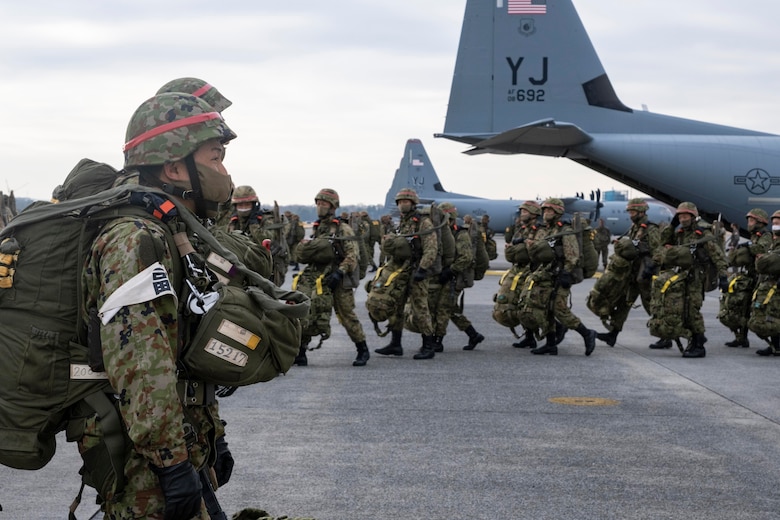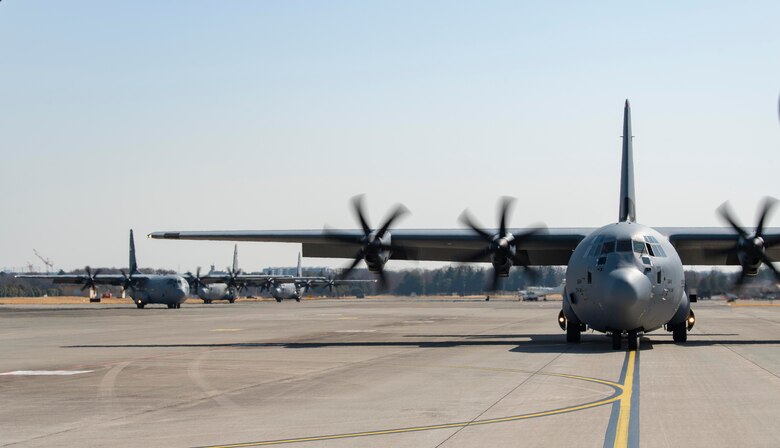In the bright Japanese morning sun, stretched across the flightline, more than 500 Japan Ground Self-Defense Force members talk, rehearse jump procedures and shimmy parachute packs onto their backs. All the while, U.S. Air Force Airmen prepare 12 C-130J Super Hercules for a surge unlike any other on record.
The first day of history in the making for the U.S. and Japan partnership was full of energy, excitement and critical focus.
The 374th Airlift Wing supported the JGSDF, 1st Airborne Brigade, for the largest static-line personnel jump and cargo drop between the U.S. and Japan, for exercise Airborne 21, March 9 to 11.
During the exercise, C-130Js launched from Yokota Air Base carrying the JGSDF soldiers, and conducted a successful air assault at the Combined Arms Training Center Camp Fuji drop zone, followed by a cargo airdrop of 134 container delivery system bundles for the JGSDF troops on the ground, two days later.
"The main purpose of this operation was to demonstrate the JGSDF's capability to employ airborne insertion anywhere in the country of Japan," said Capt. Christopher Espinosa, 36th Airlift Squadron pilot and Airborne 21 mission commander. "It was a great training opportunity to take lessons learned and how we can advance in our training in the future and also it was an effective example of a deterrent to some of our peer adversaries."
An operation of this scale needs an all-hands-on-deck approach and could not have been accomplished without the support and dedication of many Yokota AB Airmen.
The 374th Maintenance Group spent countless hours overcoming a variety of maintenance-production challenges in the weeks prior to the surge in order to provide a maximum number of mission-ready aircraft while simultaneously continuing to maintain local flying-production commitments, said Maj. David Perkins, 374th Aircraft Maintenance Squadron operations officer.
"This was not an overnight effort; to generate more than 80% of Yokota AB's C-130J fleet required months of extensively-planned logistics for the aircraft to be available, as well as planning and orchestration of the aircraft parking plan, and proper resourcing of aircraft configurations in order to make the mission happen," Perkins said. "For exercise Airborne 21, maintainers stepped up to the plate to generate 12 C-130J aircraft, ensuring a well-coordinated, multi-day, bilateral airdrop as a demonstration of airpower and a deterrence capability that is unmatched."
Over the course of three days, the JGSDF brought the CDS bundles to the 374th Logistics Readiness Squadron Combat Mobility Flight docks to store them until they were ready to load on the C-130's.
To increase bundle delivery capabilities, the 730th Air Mobility Squadron provided forklifts to be used to transport the equipment to the C-130's, said Staff Sgt. Samuel Fletcher, 374th LRS CMF supervisor. The work done during the download and upload of the bundles resulted in zero malfunctions for the flight.
With the aircraft primed by the maintainers, and fully loaded with the CDS bundles, the 36th AS loadmasters went over checklist procedures to secure the cargo for airdrop.
"Due to the fact that both mission types are inherently high risk to not only the aircraft, but everyone involved, it's extremely important for us to maintain strict checklist discipline which helps ensure drop accuracy and safety of jumpers," said Tech. Sgt. Barney Barnette, 36th AS loadmaster.
All of the hard work and attention to detail by the 347th AW Airmen, in all facets of this operation, from aircraft maintenance to bundle checks, to loading procedures, to the facilitation of getting more than 500 JGSDF personnel on base, guaranteed this historic operation was a total success, Espinoza said. This operation furthered our capabilities to provide regional security in the Indo-Pacific.
"It was an opportunity for us to foster our working relationship and to continue to build those bonds between our nation's and our units," Espinoza said. "This was an airlift that I've never seen in real life before. I've definitely studied it, planned and trained for it, but to actually execute at that magnitude was an incredible opportunity and to be chosen as one of the leaders for it and partner with the 1st Airborne was outstanding."

Japan Ground Self Defense Force paratroopers line up to board a C-130J Super Hercules, assigned to the 374th Airlift Wing, during exercise Airborne 21 at Yokota Air Base, Japan, March 9, 2021. More than 500 JGSDF paratroopers performed a static-line jump at the Combined Arms Training Center Drop Zone Camp Fuji, Japan, making it the largest U.S-Japan personnel drop in the history of the two countries' alliance. (U.S. Air Force photo by Staff Sgt. Gabrielle Spalding)

A Japan Ground Self Defense Forces paratrooper jumps out of a C-130J Super Hercules assigned to the 36th Airlift Squadron during an Airborne 21 exercise, over the Combined Arms Training Center Camp Fuji, Japan, March 9, 2021. Airborne 21 was the largest U.S.- Japan airborne operation in history; involving approximately 500 JGSDF paratroopers, 12 C-130s and 134 containment delivery system bundles. (U.S. Air Force photo by Senior Airman Hannah Bean)

C-130J Super Hercules taxi across the flightline following an equipment airdrop as part of exercise Airborne 21, at Yokota Air Base, Japan, March 11, 2021. During the exercise, approximately 500 Japan Ground Self Defense Force paratroopers performed a static-line jump from 12 U.S. Air Force C-130's, making it the largest personnel drop in history between the U.S. and Japan. (U.S. Air Force photo by Staff Sgt. Gabrielle Spalding)

A U.S. Air Force C-130J Super Hercules aircraft drops Japanese soldiers over Combined Arms Training Center, Camp Fuji, Japan, March 9, 2021, during the Airborne 21 exercise. Airborne 21 is considered the largest U.S.-Japan airborne operation in history. (U.S. Air Force photo by Yasuo Osakabe)






